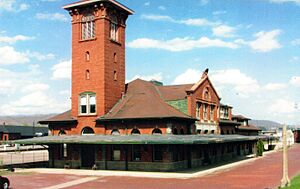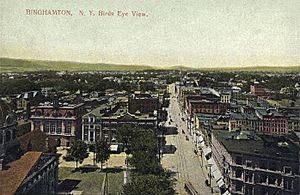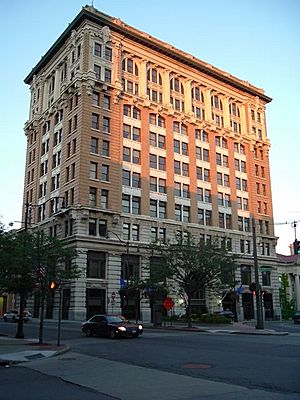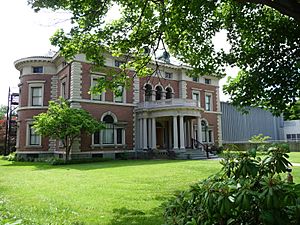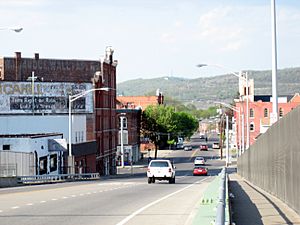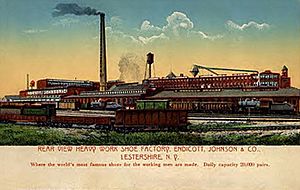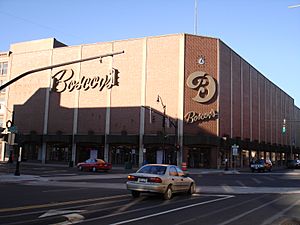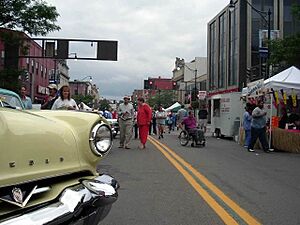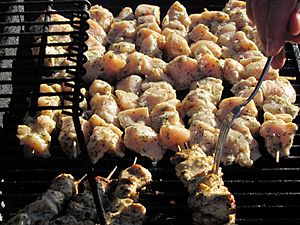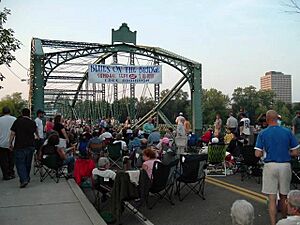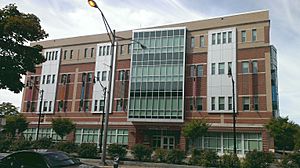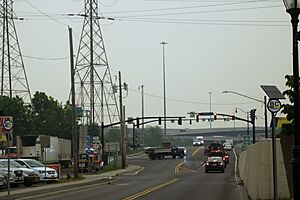Binghamton, New York facts for kids
Quick facts for kids
Binghamton, New York
|
||
|---|---|---|

Clockwise from top: Downtown Binghamton skyline, the Endicott Johnson Square Deal Arch, the South Washington Street Bridge, the Ross Park Zoo carousel, Court Street Historic District, downtown in winter, and the Spiedie Fest and Balloon Rally
|
||
|
||
| Nicknames:
The Parlor City, Carousel Capital of the World, Valley of Opportunity
|
||
| Motto(s):
Restoring the Pride.
|
||
| Country | United States | |
| State | New York | |
| County | Broome | |
| Settled | 1800 | |
| Incorporated (village) | 1834 | |
| Incorporated (city) | 1867 | |
| Government | ||
| • Type | Mayor-Council | |
| Area | ||
| • City | 11.13 sq mi (28.82 km2) | |
| • Land | 10.48 sq mi (27.14 km2) | |
| • Water | 0.65 sq mi (1.68 km2) 5.83% | |
| Elevation | 866 ft (264 m) | |
| Population
(2020)
|
||
| • City | 47,969 | |
| • Density | 4,577.63/sq mi (1,767.39/km2) | |
| • Urban | 158,084 | |
| • Metro | 247,138 | |
| Demonym(s) | Binghamtonian | |
| Time zone | UTC−5 (EST) | |
| • Summer (DST) | UTC−4 (EDT) | |
| ZIP code |
139xx (13901 = downtown)
|
|
| Area code(s) | 607 | |
| FIPS code | 36-007-06607 | |
Binghamton is a city in New York, United States. It's the main city of Broome County. The city is in a valley where the Susquehanna and Chenango Rivers meet. It is surrounded by hills near the Pennsylvania border.
Binghamton is often called the Carousel Capital of the World because of its many old carousels. It was also known as the Valley of Opportunity. This was because many jobs were available in factories and businesses. The city was a big center for making things and for transportation. It was known for cigars, shoes, and computers. IBM started nearby, and the flight simulator was invented here. This led to many electronics and defense companies.
Today, Binghamton still has some high-tech companies. But it is also becoming a center for healthcare and education. Binghamton University plays a big role in this change. The city's population was 47,969 in 2020. The larger Binghamton area has about a quarter million people.
Contents
History of Binghamton
How Binghamton Started
The first European people came to this area in 1779 during the American Revolutionary War. They were soldiers from the Sullivan Expedition. The city is named after William Bingham, a rich man from Philadelphia. He bought 10,000 acres of land here in 1786.
Joshua Whitney, Jr., who worked for Bingham, chose the spot where the Chenango and Susquehanna Rivers meet. He wanted to build a town there. This place was first called Chenango Point. In 1800, Whitney started building the first streets and homes. He helped build the first bridge in 1808.
Because the town grew so much, it became a village in 1834. It was officially renamed Binghamton.
Growing as a Manufacturing Hub
The Chenango Canal was finished in 1837. This canal helped Binghamton connect to the Erie Canal. It also helped the area start to grow with factories. This growth sped up when the Erie Railroad arrived in 1849. Soon after, the Delaware, Lackawanna and Western Railroad also came. This made Binghamton an important transportation center.
In 1867, Binghamton became a city. It was called the Parlor City because of its many fancy homes. In the late 1800s and early 1900s, many immigrants moved here. They found lots of jobs. In the 1880s, Binghamton was the second-biggest maker of cigars in the U.S.
By the 1920s, Endicott Johnson became the biggest employer. This company made shoes and offered many benefits to its workers. More Europeans came to Binghamton, and the area became known as the Valley of Opportunity.
In 1913, a big fire at the Binghamton Clothing Company killed 31 people. This led to new safety rules for buildings in New York. Major floods in 1935 and 1936 also caused deaths and destroyed a bridge. After these floods, the city built flood walls along the rivers.
During World War II, Binghamton kept growing. IBM, which started nearby, became a global leader in technology. Also, Edwin Link invented the flight simulator in Binghamton. These two things helped the area become a high-tech economy. Other big companies included Ansco and General Electric. The city's population reached its highest point in the mid-1950s, with about 85,000 people.
Changes and Recovery
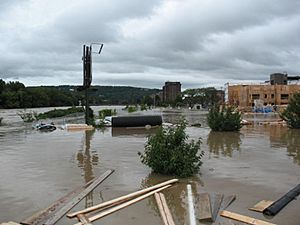
After the war, many people moved to the suburbs. This caused the city's population to shrink. Like many other older industrial cities, Binghamton lost many factory jobs. However, its technology industry helped lessen the impact.
In the 1960s and 1970s, the city tried to rebuild. Many old buildings were torn down to make way for new ones. These included Government Plaza and the Broome County Veterans Memorial Arena. These projects made Binghamton the main government and cultural center of the region. But the city's population still went down.
When the Cold War ended in 1991, defense companies in Binghamton faced problems. IBM, for example, laid off thousands of workers. The local economy went into a tough time. Many manufacturing jobs were lost.
In the 2000s, Binghamton started to change its economy. It focused more on services and healthcare. Binghamton University has been a big part of this change. The university built a downtown campus in 2007. This has brought more students to live downtown. It has also helped new businesses open.
However, two big floods have made recovery harder. In 2011, Tropical Storm Lee caused a lot of damage. The flood walls were topped, and the area had about $1 billion in damage.
Geography
City Layout
Binghamton covers about 11.14 square miles (28.82 square kilometers). Most of this is land, with a small part being water.
The city is on the Allegheny Plateau, which means it has many hills. Downtown Binghamton is about 860 feet (262 meters) high. But homes in the hills can be over 1,800 feet (548 meters) high. The highest point is Table Rock Ridge, at 1,854 feet.
Downtown is where the Chenango and Susquehanna Rivers meet. The Susquehanna River flows south of downtown. The Chenango River joins it from the north at Confluence Park. The Binghamton River Trail is a 1.5-mile path along the Chenango River. There are eleven bridges over the rivers in the city. Binghamton has many levees (walls) to protect against floods. Big floods happened in 1865, 1935, 1936, 2006, and 2011.
The city was planned with a grid system. But as it grew and joined with other small towns, the roads became less organized. In the Southside, for example, roads are more curvy.
Binghamton has several historic areas. The Railroad Terminal Historic District has old factories and buildings near the railroad. The Abel Bennett Tract Historic District on the West Side has over 1,000 homes. Downtown's State Street-Henry Street Historic District has older low-rise buildings. The Court Street Historic District has some of the city's most famous buildings. These include the Press Building and the Security Mutual Building. The Press Building was the tallest building until the State Office Building was built.
Outside of downtown, most buildings are homes or small businesses. Along the old railroad lines, there are several abandoned factories.
Main Street goes through the West Side. It continues into Johnson City and Endicott. On the east side of the Chenango River, it becomes Court Street. This is a main road in downtown and the East Side.
Neighborhoods
Binghamton has seven neighborhoods:
- Downtown (Center City) has the biggest buildings and government offices. It's also becoming popular with college students and has a growing arts scene.
- The North Side is across the railroad tracks from downtown. It's a mix of small businesses and homes. Chenango Street is its main road.
- The East Side is east of the Brandywine Highway. It's mostly homes with some businesses along Robinson and Court streets.
- The West Side is across the Chenango River. It's mostly homes, from family houses to student housing and large mansions. Main Street has many stores, restaurants, and services.
- The First Ward is a residential area known for "Antique Row" on Clinton Street. Many Christian churches with gold domes are here, built by immigrants from Eastern Europe. It also has supermarkets and small shops.
- Ely Park is the northernmost neighborhood. It has the city's golf course and is on Prospect Mountain.
- The Southside is along the south bank of the Susquehanna River. It connects to downtown by several bridges. Southside East has working-class homes. Southside West has larger middle-class homes.
Climate
| Weather chart for Binghamton, New York | |||||||||||||||||||||||||||||||||||||||||||||||
|---|---|---|---|---|---|---|---|---|---|---|---|---|---|---|---|---|---|---|---|---|---|---|---|---|---|---|---|---|---|---|---|---|---|---|---|---|---|---|---|---|---|---|---|---|---|---|---|
| J | F | M | A | M | J | J | A | S | O | N | D | ||||||||||||||||||||||||||||||||||||
|
2.5
29
16
|
2.3
32
17
|
3
41
25
|
3.4
54
36
|
3.6
66
46
|
4.3
74
55
|
3.7
78
60
|
3.5
77
58
|
3.6
68
51
|
3.3
57
40
|
3.3
45
31
|
2.8
33
21
|
||||||||||||||||||||||||||||||||||||
| temperatures in °F precipitation totals in inches |
|||||||||||||||||||||||||||||||||||||||||||||||
|
Metric conversion
|
|||||||||||||||||||||||||||||||||||||||||||||||
Binghamton has a climate with cold, snowy winters and warm, wet summers. Summers are usually warm but mild. Temperatures rarely go above 90°F (32°C). The highest recorded temperature was 98°F (37°C) in 1988. Winters are colder, with temperatures sometimes dropping below 0°F (-18°C). The lowest was -20°F (-29°C) in 1957.
It rains or snows often in Binghamton throughout the year. Binghamton is one of the rainiest cities in the U.S., with 162 rainy days a year. It's also one of the cloudiest cities. This is because it's close to the Great Lakes. Weather systems pick up moisture from the lakes, leading to more clouds and rain or snow.
Snowfall is heavy, with about 84.4 inches (214 cm) each year. Binghamton gets snow from the Great Lakes and also from big winter storms called nor'easters.
| Climate data for Binghamton, New York (Greater Binghamton Airport; elevation 1636 feet), 1991–2020 normals, extremes 1951–present | |||||||||||||
|---|---|---|---|---|---|---|---|---|---|---|---|---|---|
| Month | Jan | Feb | Mar | Apr | May | Jun | Jul | Aug | Sep | Oct | Nov | Dec | Year |
| Record high °F (°C) | 63 (17) |
70 (21) |
82 (28) |
89 (32) |
89 (32) |
94 (34) |
98 (37) |
95 (35) |
96 (36) |
85 (29) |
77 (25) |
65 (18) |
98 (37) |
| Mean maximum °F (°C) | 53.2 (11.8) |
52.2 (11.2) |
62.9 (17.2) |
76.7 (24.8) |
83.8 (28.8) |
86.7 (30.4) |
88.6 (31.4) |
86.9 (30.5) |
83.9 (28.8) |
75.0 (23.9) |
65.1 (18.4) |
54.6 (12.6) |
90.4 (32.4) |
| Mean daily maximum °F (°C) | 29.5 (−1.4) |
32.2 (0.1) |
40.7 (4.8) |
54.2 (12.3) |
66.2 (19.0) |
74.0 (23.3) |
78.4 (25.8) |
76.7 (24.8) |
69.5 (20.8) |
57.1 (13.9) |
45.1 (7.3) |
34.3 (1.3) |
54.8 (12.7) |
| Daily mean °F (°C) | 22.5 (−5.3) |
24.5 (−4.2) |
32.3 (0.2) |
44.6 (7.0) |
56.2 (13.4) |
64.4 (18.0) |
68.9 (20.5) |
67.3 (19.6) |
60.0 (15.6) |
48.8 (9.3) |
37.9 (3.3) |
28.1 (−2.2) |
46.3 (7.9) |
| Mean daily minimum °F (°C) | 15.5 (−9.2) |
16.9 (−8.4) |
24.0 (−4.4) |
35.0 (1.7) |
46.1 (7.8) |
54.9 (12.7) |
59.4 (15.2) |
58.0 (14.4) |
50.6 (10.3) |
40.5 (4.7) |
30.7 (−0.7) |
21.9 (−5.6) |
37.8 (3.2) |
| Mean minimum °F (°C) | −3.6 (−19.8) |
−0.7 (−18.2) |
6.7 (−14.1) |
21.9 (−5.6) |
33.2 (0.7) |
42.3 (5.7) |
50.5 (10.3) |
47.9 (8.8) |
36.1 (2.3) |
28.2 (−2.1) |
16.2 (−8.8) |
4.7 (−15.2) |
−6 (−21) |
| Record low °F (°C) | −20 (−29) |
−18 (−28) |
−7 (−22) |
9 (−13) |
24 (−4) |
33 (1) |
39 (4) |
37 (3) |
25 (−4) |
17 (−8) |
0 (−18) |
−18 (−28) |
−20 (−29) |
| Average precipitation inches (mm) | 2.62 (67) |
2.41 (61) |
3.05 (77) |
3.63 (92) |
3.78 (96) |
4.69 (119) |
3.80 (97) |
4.10 (104) |
4.01 (102) |
3.76 (96) |
3.11 (79) |
3.08 (78) |
42.04 (1,068) |
| Average snowfall inches (cm) | 20.6 (52) |
19.7 (50) |
16.4 (42) |
3.8 (9.7) |
0.1 (0.25) |
0.0 (0.0) |
0.0 (0.0) |
0.0 (0.0) |
0.0 (0.0) |
1.0 (2.5) |
6.8 (17) |
18.1 (46) |
86.5 (220) |
| Average extreme snow depth inches (cm) | 9.5 (24) |
10.4 (26) |
9.8 (25) |
2.0 (5.1) |
0.1 (0.25) |
0.0 (0.0) |
0.0 (0.0) |
0.0 (0.0) |
0.0 (0.0) |
0.4 (1.0) |
3.4 (8.6) |
7.6 (19) |
16.2 (41) |
| Average precipitation days (≥ 0.01 in) | 16.2 | 13.9 | 14.8 | 14.1 | 14.2 | 12.4 | 12.6 | 11.1 | 11.3 | 13.3 | 13.9 | 16.3 | 164.1 |
| Average snowy days (≥ 0.1 in) | 16.5 | 14.0 | 10.5 | 3.6 | 0.2 | 0.0 | 0.0 | 0.0 | 0.0 | 0.9 | 5.9 | 12.9 | 64.5 |
| Average relative humidity (%) | 74.0 | 72.4 | 69.3 | 64.9 | 67.0 | 72.0 | 72.0 | 75.4 | 78.1 | 73.8 | 76.4 | 78.4 | 72.8 |
| Average dew point °F (°C) | 13.8 (−10.1) |
14.7 (−9.6) |
22.6 (−5.2) |
31.5 (−0.3) |
43.5 (6.4) |
54.0 (12.2) |
58.5 (14.7) |
57.9 (14.4) |
51.8 (11.0) |
39.9 (4.4) |
30.7 (−0.7) |
20.3 (−6.5) |
36.6 (2.6) |
| Mean monthly sunshine hours | 113.0 | 125.9 | 172.5 | 205.1 | 252.4 | 274.6 | 295.3 | 256.8 | 202.0 | 162.5 | 92.9 | 79.7 | 2,232.7 |
| Percent possible sunshine | 38 | 43 | 47 | 51 | 56 | 60 | 64 | 60 | 54 | 47 | 32 | 28 | 50 |
| Source: NOAA (relative humidity, dew point, and sun 1961–1990) | |||||||||||||
Population and People
| Historical population | |||
|---|---|---|---|
| Census | Pop. | %± | |
| 1830 | 1,203 | — | |
| 1840 | 2,800 | 132.8% | |
| 1850 | 6,000 | 114.3% | |
| 1860 | 8,325 | 38.8% | |
| 1870 | 12,692 | 52.5% | |
| 1880 | 17,317 | 36.4% | |
| 1890 | 35,005 | 102.1% | |
| 1900 | 39,647 | 13.3% | |
| 1910 | 48,443 | 22.2% | |
| 1920 | 66,800 | 37.9% | |
| 1930 | 76,662 | 14.8% | |
| 1940 | 78,309 | 2.1% | |
| 1950 | 80,674 | 3.0% | |
| 1960 | 75,941 | −5.9% | |
| 1970 | 64,123 | −15.6% | |
| 1980 | 55,860 | −12.9% | |
| 1990 | 53,008 | −5.1% | |
| 2000 | 47,380 | −10.6% | |
| 2010 | 47,376 | 0.0% | |
| 2020 | 47,969 | 1.3% | |
| Historical Population Figures | |||

In 2010, Binghamton had 47,376 people. There were 21,150 households. About 20.8% of households had children under 18.
Diversity in Binghamton
Binghamton has many different groups of people. When factories were booming, thousands of European immigrants moved here. Many people from Ireland, Italy, and Eastern Europe settled in the area. The American Civic Association was created to help them.
This mix of cultures led to many different churches and festivals. The First Ward, for example, has several gold-domed Orthodox churches. The Catholic Church is the largest religious group in Broome County.
In 2010, Binghamton's population was mostly White (77.6%). It also had Black or African American (11.4%), Asian (4.2%), and Hispanic or Latino (6.4%) people. Binghamton also has a noticeable Kurdish community.
Population Changes
Binghamton's population grew quickly until the mid-1950s because of its factories. It was one of the 100 largest cities in the U.S. between 1890 and 1910. But since 1950, the city's population has been shrinking. Many people moved to the suburbs. The region has also lost younger people, so there are more older people in Broome County.
Binghamton's Larger Area
The Binghamton metropolitan area includes Broome County and Tioga County. In 2020, about 247,138 people lived in this larger area. The urban area, which includes parts of Pennsylvania, has about 158,054 people.
Income and Poverty
The average household income in Binghamton was $30,978. About 33.3% of the people lived below the poverty line. This included 47.3% of those under 18.
Economy
After the cigar industry boom in the 1880s, Binghamton relied on big factories. Endicott Johnson, a shoe company, and IBM each employed 15,000 to 20,000 people at their busiest times. Other important companies included Link Aviation Devices, Ansco, and General Electric.
Many famous businesses started in Binghamton. These include Valvoline and the Nineteen Hundred Washer Company (which became Whirlpool). Dick's Sporting Goods began as a fishing store here in 1948.
Today, Binghamton still has many technology and defense manufacturing jobs. But this sector has been shrinking since 1990. Companies like Lockheed Martin, BAE Systems, IBM, and Universal Instruments are still here. McIntosh Laboratory makes high-end audio equipment.
Education and healthcare are growing parts of the economy. Binghamton University and Broome Community College employ many teachers and researchers. Binghamton University has a special center for small-scale systems. It also helps new technology companies get started. Upstate Medical University has a campus here. Major healthcare companies include United Health Services and Lourdes Hospital.
Binghamton also has many food service and distribution companies. Maines Paper & Food Service and Willow Run Foods are two of the largest food distributors in the U.S. They are based here. Crowley Foods and Frito-Lay also have a presence.
Farming has always been important here. The farm bureau movement started in Binghamton in 1911.
Other big employers include New York State Electric & Gas and Johnson Outdoors. Two insurance companies, Security Mutual Life and Columbian Financial Group, are also based here.
The area has several large shopping areas. Downtown Binghamton has a Boscov's department store. More students living downtown have led to new restaurants and businesses. Most big shopping centers are now in the suburbs. Johnson City has the Oakdale Mall. The First Ward has "Antique Row" with many antique shops.
Arts and Culture
Since the early 2000s, Binghamton has developed a lively arts scene. There are many art galleries and shops downtown. These galleries host the First Friday Art Walk, which brings many people downtown. Famous local artists include Anthony Brunelli and Orazio Salati.
The Binghamton Philharmonic is the area's main professional orchestra. It performs classical and other music all year. The Tri-Cities Opera performs full operas. It is known for training opera singers. There are also other local orchestras and theaters.
The Roberson Museum and Science Center is in Binghamton. It has a visitor center, a planetarium, and exhibits about the area's history and culture. The Kopernik Observatory & Science Center is the largest public observatory in the northeastern U.S. The Binghamton Zoo at Ross Park, opened in 1875, is the fifth-oldest zoo in the country.
Binghamton is called the Carousel Capital of the World. It has six of the old antique carousels still working. Two are in the city: one at Recreation Park and one at the Binghamton Zoo. Other places to visit include the Phelps Mansion museum, the Cutler Botanic Garden, and the Bundy Museum of History and Art. The Discovery Center is an interactive museum for children.
The area is famous for a local dish called the spiedie. Many restaurants serve spiedies. They are celebrated at the Spiedie Fest and Balloon Rally every August. This event attracts over 100,000 people.
Other annual events include:
- The St. Patrick's Day parade in March.
- July Fest, a jazz and arts festival held downtown since 1962.
- The St. Mary of the Assumption Bazaar in August.
- The LUMA Projection Arts Festival in September.
- Binghamton Porchfest, a free music festival on West Side porches.
- Blues on the Bridge, a music festival on the South Washington Street Bridge in September.
- The Columbus Day Parade and Italian Festival in October.
Broome County has many festivals, especially ethnic celebrations.
People in Binghamton usually speak the Inland Northern dialect of American English. They often say "sneakers" for athletic shoes and "soda" for soft drinks.
Sports
Professional and Semi-Pro Teams
Binghamton has a long history with minor league sports. The Eastern League for baseball started here in 1923. Today, the city has two professional minor league teams:
- The Binghamton Rumble Ponies (baseball, linked with the New York Mets).
- The Binghamton Black Bears (ice hockey, in the Federal Prospects Hockey League).
In 2018, Binghamton was ranked as the 10th best minor-league sports market in the country.
| Club | Sport | League | Founded | Venue | League titles |
Championship years |
|---|---|---|---|---|---|---|
| Binghamton Black Bears | Ice hockey | Federal Prospects Hockey League | 2021 | Visions Veterans Memorial Arena | 1 | 2024 |
| Binghamton Rumble Ponies | Baseball | Double-A Northeast | 1992 | Mirabito Stadium | 3 | 1992, 1994, 2014 |
| Binghamton Bulldogs | Basketball | American Basketball Association | 2017 | St. Patrick's Gym | 0 | — |
| Broome County Stallions | Football | Empire Football League | 2018 | Stallions Field | 0 | — |
Baseball
The Binghamton Rumble Ponies are the Double-A team for the New York Mets. Many famous players like Daniel Murphy and David Wright played for Binghamton before going to the major leagues.
Binghamton has a long history in professional baseball since 1877. Teams like the Crickets, Bingoes, and Triplets played here. The 1887 Binghamton Bingoes team had a problem with its two black players. This led to changes in the league.
The Binghamton Triplets were a farm team for the New York Yankees from 1932 to 1968. Hall of Fame pitcher Whitey Ford played for the Triplets in 1949.
Football
Binghamton has had semi-professional football teams. The Broome County Dragons and Southern Tier Green Machine played here. There were also women's football teams, the Binghamton Tiger Cats and Southern Tier Spitfire. As of 2015, these teams no longer play. The Broome County Stallions started in 2018.
Golf
The B.C. Open was a PGA Tour golf event held in nearby Endicott from 1971 to 2005. Since 2007, the area has hosted the Dick's Sporting Goods Open, a PGA Tour Champions event. It is also played at En-Joie Golf Course.
Hockey
Professional hockey came to Binghamton in 1973 with the Broome Dusters. The Dusters were known for their exciting style of play. Fans loved them so much that Binghamton was called "Hockey Town USA." Later, the team became the Binghamton Dusters, then the Binghamton Whalers (1980–1990), and the Binghamton Rangers (1990–1997).
The Binghamton Senators were the AHL team for the Ottawa Senators. They won the Calder Cup in 2011. Many players from the B-Sens went on to play in the NHL. The B-Sens moved to Canada in 2017.
Then, the New Jersey Devils brought their AHL team, the Binghamton Devils, here. They played at the Floyd L. Maines Veterans Memorial Arena. The B-Devils moved in 2020.
In 2021, a new hockey team, the Binghamton Black Bears, started playing in the Federal Prospects Hockey League. In May 2024, the Black Bears won the Commissioner's Cup.
Tennis
From 1994 to 2019, Binghamton hosted an annual professional tennis tournament. It was part of the ATP Challenger Tour. Famous tennis players like Lleyton Hewitt and Andy Murray played in this tournament early in their careers.
College Sports
Binghamton University has Division I college sports teams. They are part of the America East Conference. Broome Community College has Division III sports.
Motorsports
Since 1978, a round of the American Motorcyclist Association's Motocross Championship was held at the Broome-Tioga Sports Center. This event has now moved to Texas. The center still hosts the New York State Motocross Championships and other events.
Parks and Recreation
Binghamton is known for its places to bike and walk. The Binghamton River Trail is a path along the Chenango River. It goes from Confluence Park to Cheri A. Lindsey Park.
Education
Schools for Kids
The public Binghamton City School District is the largest school district in the area. It has about 5,000 students. The district includes Binghamton High School, two middle schools, and seven elementary schools. It has an International Baccalaureate program.
The Catholic Schools of Broome County run Seton Catholic Central High School and an elementary school in the city.
Colleges and Universities
Binghamton has three college campuses:
- The downtown campus of Binghamton University. This is part of the SUNY system.
- A campus of State University of New York Upstate Medical University. Medical students spend their last two years of training here.
- An Empire State College location in the State Office Building.
The main campus of Binghamton University is in nearby Vestal. It is one of the top public universities in the SUNY system, with about 15,000 students. It is known for its research. Many students live in the West Side. The university also helps new technology companies downtown.
SUNY Broome is just north of the city. It is a two-year SUNY college with 6,000 students. It offers many different courses. The college is turning the old Carnegie Library into a culinary and event center.
Davis College, a Bible college, is in nearby Johnson City.
Media
The Press & Sun-Bulletin is Binghamton's main daily newspaper. The area has several TV stations linked to major networks like CBS, NBC, ABC, and Fox. WSKG-TV is the local PBS station. Most radio stations are owned by a few large groups.
City Services
Transportation
Binghamton is a major meeting point for highways. Interstate 81 goes north to Syracuse and south to Pennsylvania. Interstate 88 goes east to Albany. New York State Route 17, which is becoming Interstate 86, connects to New York City and western New York. Other main roads include the Brandywine Highway and Main Street.
B.C. Transit provides local bus service. Binghamton University students also have a bus service. Long-distance buses leave from the Greater Binghamton Transportation Center. Companies like Greyhound Lines and OurBus offer routes to other cities.
The Greater Binghamton Airport (BGM) is a small airport with flights to Detroit and Orlando. The region's airport for smaller planes is Tri-Cities Airport in Endicott.
Three freight railroads serve Binghamton. There is no passenger train service in Binghamton anymore.
Utilities
New York State Electric and Gas provides electricity and natural gas. Charter Spectrum is the main cable and internet provider. Verizon also offers phone and internet. The city handles garbage, recycling, and street lights.
The city government manages water and sewer services. Binghamton gets its drinking water from the Susquehanna River. Sewage is treated and released back into the river. The sewage plant was badly damaged by Tropical Storm Lee in 2011.
Healthcare
United Health Services (UHS) runs Binghamton General Hospital and Wilson Medical Center in Johnson City. Lourdes Hospital is run by Ascension Health. The Dr. Garabed A. Fattal Community Free Clinic offers services with the Broome County Health Department.
The Greater Binghamton Health Center helps with mental health. It will become a special center for children's behavior.
Sister Cities
Binghamton has connections with cities in other countries:
- Borovichi, Russia
- La Teste-de-Buch, France
It also has a local sister city project:
- El Charcón, El Salvador
See also
 In Spanish: Binghamton (Nueva York) para niños
In Spanish: Binghamton (Nueva York) para niños





